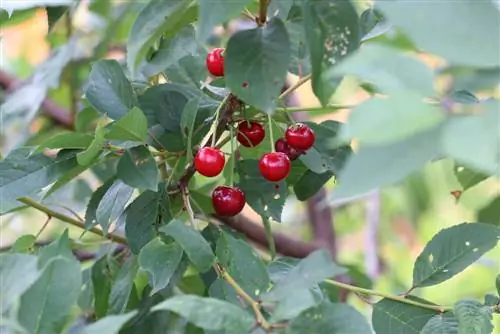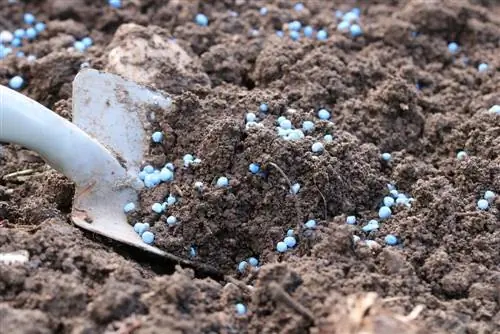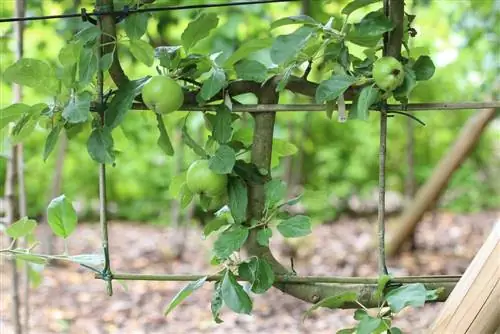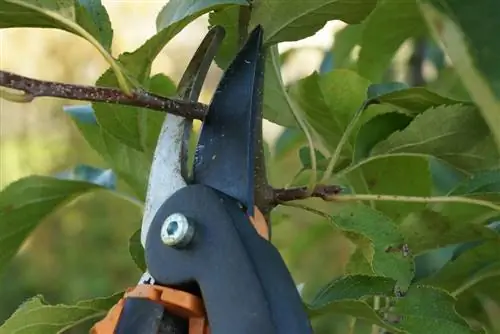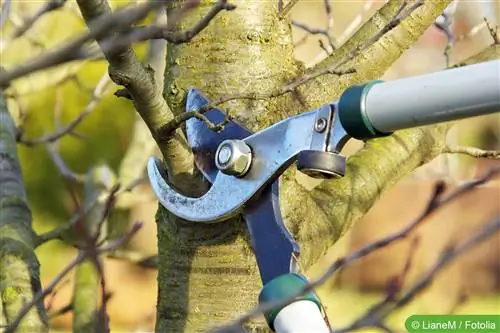- Author admin [email protected].
- Public 2023-12-17 03:39.
- Last modified 2025-06-01 06:48.
The columnar fruit is very easy to care for and even beginners can hardly go wrong with these trees as long as they follow a few care instructions. Most species deliver high yields just two to three years after purchase. There are many varieties of columnar fruit. The fruit varieties apple, plum, sweet and sour cherries, mirabelle plums, plums and pears are often found. Combinations of these types of fruit are now commercially available, such as: B. Apple-pear or cherry-plum can be found. The fruits taste just as tasty as the fruits from ordinary trees. When choosing the right columnar fruit, the appropriate varieties should be selected. For a cherry, for example, “Gisela 5” is recommended. This grows to around four meters high and delivers high yields after two to three years.
Profile
- Varieties: all types of fruit that are also available as normal trees
- Size: about 2 to 4 meters high
- Location: sunny to partially shaded, warm, no sandy, dry soils
- Pruning: shorten unwanted side shoots by 10 to 15 cm in July or August
- Care: easy to care for, thinning the fruits to prevent fluctuations in yield
- Fertilizing: organic fertilizer outdoors or liquid fertilizer several times a year for potted plants
- Overwintering: hardy, protection is particularly recommended for potted plants
- Propagation: via grafting in the nursery
- Diseases and pests: not susceptible, follow care instructions to prevent them
Location for columnar fruit
The trees are best suited for small gardens, balconies or terraces. They can be placed alone, in a fruit hedge or in a pot. The distance between several trees should be around 50 to 70 cm. The columnar fruit should be sunny to partially shaded. If the tree is too shady, it is possible that it will drop fruit too early. The soil to be planted should not be too dry or too sandy, as this is not good for the columnar fruit. The columns are usually two to four meters high.
When selecting trees, it should be noted that some types of fruit, such as sweet cherries or pears, only produce fruit if there is another tree of the same type in the immediate vicinity. You can also use your neighbor’s garden. Self-pollinated varieties do not require a second tree to provide pollen. However, you also benefit from another self-pollinating tree, as it significantly increases the crop yield through cross-pollination.
Pillar fruit - cut
Pillar apples usually don't need any pruning. However, the narrow-growing trees occasionally form longer side branches. These should be cut off immediately. No branch stubs should be left standing, otherwise new unwanted branches will form there again. Pears and cherries develop side shoots more often than the columnar apples, which often grow very slenderly upwards. The branches are best shortened by 10 to 15 cm in July or August. This approach causes the trees to produce more flower buds and is the safest way to slow down the growth of the branches.
Pillar fruit - care
Repotting columnar fruit sitting in pots should be done about every five years. The soil should be replenished as needed in other years. Sufficient fertilization should also be ensured. An organic fertilizer such as compost, manure or wood shavings is suitable for this. This is incorporated around the trunk. When planting the tree, it makes sense to add some fertilizer to the soil. Trees growing in containers should be supplied with a liquid fertilizer several times a year.
Especially with columnar apples, it often happens that the trees no longer have the strength for flower buds the following year due to too many fruits in the previous year. To counteract these fluctuations in yield, a maximum of 30 apples should be left on the tree per year. All other fruits must be removed by June at the latest. Reducing yields also often makes sense for peaches or pears. Thinning the fruits is also advisable to obtain larger fruits.
Overwintering columnar fruit
The small trees are hardy and therefore also suitable for slightly colder areas. However, columnar fruit that grows in a container should be protected from frost in winter. Straw or leaves, for example, are suitable for covering. These trees should also be placed on a south-facing wall to get as much sun as possible. Alternatively, the columnar fruit can overwinter in a bucket in a bright, frost-free room. Greenhouses or winter gardens are particularly suitable for this.
The fruit left outdoors can be protected with garden fleece, which is wrapped around the trunk. Leaves and straw have proven successful on earth.
Diseases and pests of columnar fruit
Pillar fruit is not susceptible to diseases or pests. Nevertheless, it can happen from time to time that the plants are not doing well. Possible are e.g. B. Frost damage, which can occur from time to time despite the winter hardiness. These problems can be prevented by covering the tree trunks with jute bags or boards. To heal frost damage, dead tissue must be removed. A bandage made from clay, cow dung and horsetail tea can also be helpful. However, finished products are also available in stores.
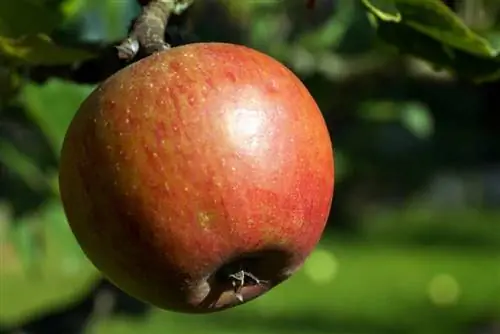
Viruses and bacteria can also transmit diseases, which can be combated using special commercial products. To avoid all diseases, the tree should be professionally cut and optimally supplied with water and nutrients. Plants that are in too little soil (pots that are too small) are more susceptible to disease. A pot with at least 25 to 30 liters capacity is recommended. To prevent harmful insects, bird nesting boxes can be attached to the tree or nearby.
What you should know about columnar fruit in brief
- Pillar fruit is ideal for people who want to harvest a lot of fresh fruit in a small space. This type of tree is the right choice for both small gardens and balconies. The columnar fruit is also recommended for people without a green thumb as it requires little care.
- A 2-4 meter high fruit tree with slender growth, such as apple, cherry or plum, is particularly suitable for small gardens, terraces or balconies. It takes up little space and can be planted well in wooden pots / terracotta pots with a capacity of at least 25 liters.
- When planting in containers, it is advisable to cover the container with straw or leaves in winter. The bucket can overwinter on a bucket roller or wooden board to prevent damage from ground frost.
- Occasional watering is recommended. You can enjoy the high fruit yield after just 2-3 years. The long side shoots should be cut back in November or February. Several types of columnar fruit can easily be placed next to each other at a distance of 60 cm.
- The columnar fruit offers the advantage of winter hardiness, good soil tolerance and high fruit set. It can also be easily fertilized with a little complete fertilizer and is not susceptible to pests and diseases. The complete fertilizer is distributed around the tree; for pots, fertilization should be carried out once a month after flowering.
- The columnar fruit prefers sunny to semi-shady places, otherwise there is a risk of fruit dropping too early. In order to limit growth and stimulate flower bud formation, summer pruning (fruit tree pruning), depending on the type of fruit, is advisable between June and August.
- Depending on the variety, a pollen donor is necessary for the columnar fruit if it is not a self-pollinating variety. With another self-pollinating variety, the yield of the crop is higher due to cross-pollination.
- Not all shoots are needed for fruit formation, so these shoots that are not yet woody can be twisted or torn out. To do this, shoots of the side buds are shortened to four eyes in order to enable the later branches to form.

